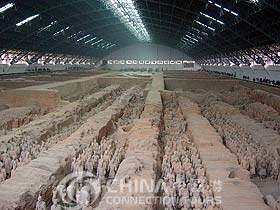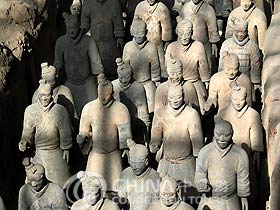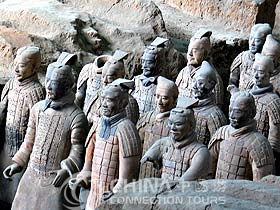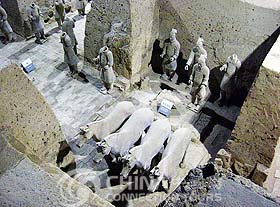

The well-known Terra-cotta Museum is located east of Emperor Qin's Mausoleum, which covers a total area of 20 hectares. Three main buildings of the museum, which were named Pit 1, Pit 2, Pit 3, were constructed on their original sites in different periods of time.
It was on March 29,1974, when local farmers of Xi Yang Village, Ling Tong Country, were drilling a series of wells in search of water, pottery fragments and ancient bronze weapons were discovered accidentally. With government approval, an archaeological team from Shaanxi Province arrived at the site on July 17,1974 and began their explorations and Qin Shihuang's Terra-cotta Museum was opened to the public. By the time of the opening ceremony, archaeologists have excavated the area of 2,000 square meters in Pit 1 and some 1,087 terra-cotta warriors and horses were displayed there after restoration. Following the discovery of Pit 1,Pit 2 and Pit 3 were brought to light in April and May of 1976. Pit 3 was opened in 1989. Pit 2 started to be excavated in March 1994 and was opened in October the same while it was being excavated. Besides three pits, two sets of bronze chariots and horses discovered in the west of Emperor Qin's Mausoleum in December in 1980, were on display in the museum after restoration.
In the last 20 years, the terra-cotta Museum has developed and become the largest on-site museum in China.More and more valuable cultural relics have been unearthed successively. Pit 1 is a huge arch-domed steel structure, located at the center of the museum with an area of 16,000 square meters. The other two pits  were built in Qin and area of 17,934 and 1,694 square meters respectively. The multiple exhibition halls lies to the east of Pit 2, covering a series of exhibits, such as two sets of bronze chariots and horses, the new findings from the Emperor Qin's Mausoleum, the history of the Museum and all kinds of temporary exhibits. These displays systematically depict the history of the Qin Dynasty from 221 BC-206 BC and can help the views to have a better understanding on the Terra-cotta Warriors and horses. The south of Pit 1 is a circle vision hall. The movie inside lasts 20 minutes and provides vivid materials for telling the story of Emperor Qin and his Terra-cotta Army 2,200 years ago. The halls on the northwest of Pit 3, which covers 4,282 square meters, are the multiple service halls where the visitors can have meal, do shopping and take a rest.
were built in Qin and area of 17,934 and 1,694 square meters respectively. The multiple exhibition halls lies to the east of Pit 2, covering a series of exhibits, such as two sets of bronze chariots and horses, the new findings from the Emperor Qin's Mausoleum, the history of the Museum and all kinds of temporary exhibits. These displays systematically depict the history of the Qin Dynasty from 221 BC-206 BC and can help the views to have a better understanding on the Terra-cotta Warriors and horses. The south of Pit 1 is a circle vision hall. The movie inside lasts 20 minutes and provides vivid materials for telling the story of Emperor Qin and his Terra-cotta Army 2,200 years ago. The halls on the northwest of Pit 3, which covers 4,282 square meters, are the multiple service halls where the visitors can have meal, do shopping and take a rest.
The three pits were built in similar basic construction. They are five to seven meters beneath the present ground level with the terra-cotta figures placed in corridors. The corridors, divided by earth-rammed partition walls, are paved with pottery bricks on which the figures were placed. The earth walls sustained wood roof that was composed of huge and strong rafters, the roof was covered by layers of fiber mats, earth fill and tilled earth. All these were constructed to totally conceal the army.
The three pits vary in size and shape. Pit 1 is the largest one in rectangular shape, housing the main force of the army; Pits 2 is located some 20 meters north of Pit 1, which is a complex battle formation formed by charioteers, archers, cavalrymen and infantrymen. It is specially used for supporting the main force; Pit 3, located 25 meters to the north of Pit 1 and to the west of pit 2, was evidently the headquarters. The total three pits are located to the east of Emperor's Mausoleum, determining that the army was facing east, with its back to the tomb, serving as guardians to protect the entrance of the Emperor's burial.
Pit 1:
 Pit 1, the largest pit, is in a rectangular shape. It measures 230 meters long from east to west, 62 meters wide from north to south and 5 meters deep, covering an area of 14,260 square meters, Five sloping roadways into the pits were constructed on eastern and western sides of pits to permit access. The terra-cotta warriors and horses are arrayed in a practical battle formation. At the eastern end of the pit there are three rows of vanguards, 68 in each, totaling 204 soldiers who were originally equipped with genuine bows and crossbows. Immediately behind the vanguards is the main body of the battle formation: 30 chariots, each of which was drawn by four horses, armored and unarmored soldiers held weapons originally, such as spears, halberds etc. Around the outer edge, there is one row of soldiers with crossbows facing south, north and west respectively as the flanks to guard the sides and rear of the army. According to the density of each trial trench that has been excavated, it’s assumed that more than 6,000 pottery warriors and horses will be unearthed from Pit 1, most of which are infantrymen.
Pit 1, the largest pit, is in a rectangular shape. It measures 230 meters long from east to west, 62 meters wide from north to south and 5 meters deep, covering an area of 14,260 square meters, Five sloping roadways into the pits were constructed on eastern and western sides of pits to permit access. The terra-cotta warriors and horses are arrayed in a practical battle formation. At the eastern end of the pit there are three rows of vanguards, 68 in each, totaling 204 soldiers who were originally equipped with genuine bows and crossbows. Immediately behind the vanguards is the main body of the battle formation: 30 chariots, each of which was drawn by four horses, armored and unarmored soldiers held weapons originally, such as spears, halberds etc. Around the outer edge, there is one row of soldiers with crossbows facing south, north and west respectively as the flanks to guard the sides and rear of the army. According to the density of each trial trench that has been excavated, it’s assumed that more than 6,000 pottery warriors and horses will be unearthed from Pit 1, most of which are infantrymen.
Located 20 meters to the north of Pit 1 at the eastern end, Pit 2 is in "L" shape with a protruding rectangular area at the northern corner. This pit was discovered in 1976, covering an area of 6,000 square meters. Different from Pit 1, over 1,300 pottery figures in Pit 2 were placed in four specialized military forces: The protruding northeast area houses 332 archers in all, 160 kneeling archers were arrayed into four columns with 172 standing archers surrounding. All these archers, whatever kneeling or standing soldiers, face eastward. The south area is composed of war chariots. Total 64 chariots were arrayed in 8 columns, also facing east, eight chariots with their chariot horses in each column. Originally made of wood, the chariots were completely deteriorated when unearthed. Each chariot in this group was accompanied with a charioteer, who was flanked by two attendant soldiers carrying long weapons. The middle area consists of war chariots in the front, immediately followed by infantrymen and the cavalry at the rear.
The north area has only cavalry. There are totally 108 cavalrymen. Each of the cavalrymen stands in front of the saddled war-horses, holding the reins in right hand and a bow in left hand. The four arrays seemed to exist independently, but could be assembled immediately to constitute a complete battle formation during the war times. This reflected the unique military strategy of the Qin army-army array within army array.
Pit 3
 It is the smallest of the three pits and was discovered in 1976. Only 68 pottery figures and one chariot drawn by four horses were unearthed in the pit. It is of U-shape about 520 square meters. Pit 3 is now known as the command center of the entire army, because the following reasons: Its position in the far northwest corner of the overall plan ensured that it was well protected by the armies of the two larger pits. At the eastern end of the pit, there is a sloping road served as the entrance, then followed by an ornate canopied chariot with canopy was colorful painted, representing higher rank. In the north and south side chambers, 64 fully armored figures were found. Unlike the soldiers in Pit 1 and Pit 2, these figures were arrayed face-to-face with their backs to the wall, suggest that they were the guards. Even the weapons held by these guards are different from those in another two pits. One particular weapon named "Shu", which had no blades, only unearthed from Pit 3, it was believed to be used by the guards of honor. In the north chamber, a piece of broken deer horn and some remains of animal bones were found at one time. They were used by generals as ritual objects for those religious practices, praying for the protection from the Gods before each battle. Once the terra-cotta warriors and horses were all arrayed inside the corridors, the entrances were closed. it meant a sealed united army was formed to guard Emperor Qin's underground palace.
It is the smallest of the three pits and was discovered in 1976. Only 68 pottery figures and one chariot drawn by four horses were unearthed in the pit. It is of U-shape about 520 square meters. Pit 3 is now known as the command center of the entire army, because the following reasons: Its position in the far northwest corner of the overall plan ensured that it was well protected by the armies of the two larger pits. At the eastern end of the pit, there is a sloping road served as the entrance, then followed by an ornate canopied chariot with canopy was colorful painted, representing higher rank. In the north and south side chambers, 64 fully armored figures were found. Unlike the soldiers in Pit 1 and Pit 2, these figures were arrayed face-to-face with their backs to the wall, suggest that they were the guards. Even the weapons held by these guards are different from those in another two pits. One particular weapon named "Shu", which had no blades, only unearthed from Pit 3, it was believed to be used by the guards of honor. In the north chamber, a piece of broken deer horn and some remains of animal bones were found at one time. They were used by generals as ritual objects for those religious practices, praying for the protection from the Gods before each battle. Once the terra-cotta warriors and horses were all arrayed inside the corridors, the entrances were closed. it meant a sealed united army was formed to guard Emperor Qin's underground palace.

